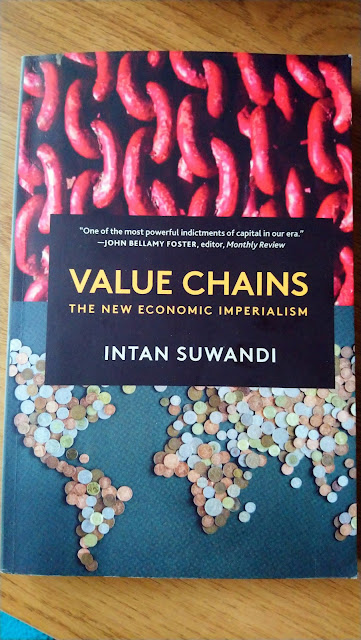Productivity growth after reading the last Michael Robert's text
On his last
text on inflation, Michael Roberts addresses the fact of highest productivity
in emergent countries than in advanced countries. We celebrate this
acknowledgement of the event unfolding, which contradicts schematic
dependentism frameworks, and puts a more realistic picture on view. Now what we
need to do, is explain why and how that is happening. How come is productivity
growing when we have a falling profit rate? Sometimes, the attention on the
profit rate as a variable, has made us forgot other variables in which, even if
the profit rate had preeminence and precedence over the macroeconomy (assuming
that hypothesis as true), the profit rate would and does depend on other variables, in order to fall: for example, a
growing organic composition. But the fall in the profit rate, affects precisely
investment, just like multinationals have gone from integrating and expanding,
to Mergers&Acquisitions, predating each other as competitors, or predating smaller
capitals and speculating, instead of investing, expanding and integrating. That
has produced a fall in gross capital formation and gross fixed capital
formation (specially the former: a bigger reduction in inventories than in
fixed assets). This obviously produces a countertendency
to the fall in the profit rate. This might explain why we haven’t gotten
into a full depression, or why has it lasted so long since 2007/8: we’re not
saying the profit rate stopped falling, as a tendency, but that this fall in
capital formation is a countertendency that might have softened or pressured
back in the opposite direction of the historical fall in the profit rate. The
fall in the profit rate itself, produces a reduction in investment, which
produces a countertendency to it’s own cause, de-accelerating or slowing down
the fall.
The
variable capital share of total expenses (compensations) has grown in Europe
and Latin America. That means the labor share is growing with respect to total
capital advanced. But the share of Subsaharan Africa, the Middle East and North
Africa and Latin America’s compensations and variable capital expenses, is much
bigger compared to capital-intensive regions like North America and Europe
(gradually also East Asia and the Pacific). Also, unemployment has grown along
with the fall in investment and capital formation, which should reduce the
labor component instead of constant capital. But also capital formation and
fixed capital formation have been much bigger in low and middle income
countries than high income, or in regions like Subsaharan Africa, East Asia and
Pacific, and Middle East and North Africa, within the overall decreasing trend
itself of both variables. This happens specially during the first decade of the
XXI century, while the second decade turns into a relative fall for all regions
alike throughout the world, that never
recovered the world average of past points.
That means
Europe and Latin America are actually in the opposite trend than a growth in organic
composition. It also means a bigger exploitation rate for those regions. But
Europe has more constant capital than Latin America, and has increased its
fixed capital formation: Europe is increasing its labor share from the perspective
of a capital intensive economy, and Latin America is also increasing its labor
share, but from the perspective of a labor intensive economy with backwards
constant capital. That creates two completely different scenarios: the
productivity growth is based mainly on a reduction of reproduction, investment
and accumulation, which augments the labor component, or at least, as a
minimum, reduces capital and fixed capital formation. Actually, the overall
trend is for rising unemployment and a downwards capital formation, so in terms
of low, middle and high income countries, the XXI century saw the rise of
middle income countries in terms of capital formation, just to slow down with
the others in the overall at the turn of the second decade, just like in the constrained expanded reproduction Mandel elaborated. But even still, the
first places are for middle and low income countries, even during this slowing
down. Those were the regions which slowly removed high income countries from the top
of the capital formation indicator, and are now at par with high income countries in terms of capital formation. That means the growth in productivity is
really based on a contraction of reproduction, mainly, but also, just like in
any productivity boost, there’s also an increasing organic composition, which
is basically, the industrialization of the “Third World” itself: a reduction in
necessary labor against surplus labor, based on augmenting its constant capital
component. This is not reducing their bigger share of labor compared to high income countries, but it’s a
contradictory pressure.
The difference in the inverted relationship between the organic compositions of high income countries, and the organic compositions of middle and low income countries: since the lower and middle income countries have a bigger labor component, they can contract their investment in capital and fixed capital formation, and at the same time, doing it in a smaller proportion than the contraction of labor through unemployment. So the lower and middle income countries are contracting their investment as well, but in a smaller proportion related to constant capital, and on a bigger proportion in terms of labor. Since it has more than double the share of labour than high income countries, it won't change its position as labor-intensive processes, or regions with a backwards organic composition. This contraction but in a smaller proportion, helps them increase their positions internationally in terms of capital and fixed capital formation, although with receding labor shares at the same time. The bigger reduction is in terms of labor, obviously, through higher unemployment.

